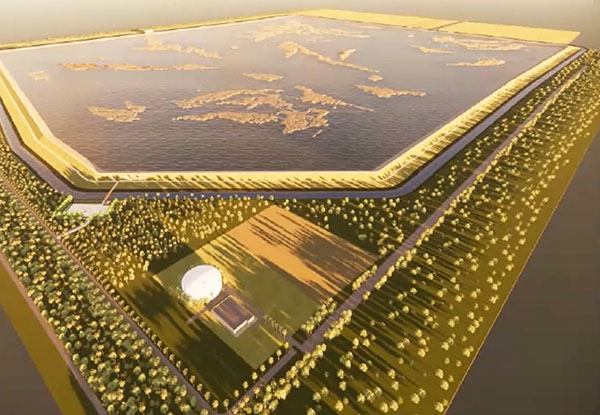What has earthen walls that are 20.5 feet high with a perimeter of 5.5 miles, covers 1,600 acres and when filled will contain approximately 3 billion gallons of water?
Answer: The reservoir that the South Florida Water Management District is planning to build over the next six years next to Seminole Pratt Whitney Road north of Northlake Blvd. The structure, also known as an impoundment, is across from 100th Lane North and just west of the 3,900 homes going up in the Avenir development.
More homes lie to the south of the site in The Acreage, in an area known as the “Top Hat” and beyond.
Three aspects of the C-18W Impoundment Project must be approved by the Indian Trail Improvement District — construction of a pump station, issues related to its ongoing maintenance and SFWMD access to the district’s M-0 Canal.
“We have some say because we’re the water district,” ITID Executive Director Burgess Hanson said last week. “They’re relying on our M-0 Canal. The board hasn’t taken a formal position.”
The main purpose of the project is to improve freshwater flows to the Northwest Fork of the Loxahatchee River, which is a nationally designated Wild and Scenic River, and restore the wetlands and watersheds that feed it, the SFWMD’s Lead Project Manager Jeff Buck told the ITID Board of Supervisors during a presentation earlier this year.
“I don’t know how I feel about it yet,” ITID President Elizabeth Accomando said recently. “[But] I have confidence that the South Florida Water Management District can properly, effectively and safely store the water, and it’s needed.”
However, Supervisor Betty Argue said during the presentation that it “just seems irresponsible to put that right beside thousands and thousands of homes.”
“Since this is a high-hazard dam, the interior of the embankment is going to be lined with a soil-cement mix,” Senior Project Manager Michael Tompkins said. “That will make it more resistant to wave action during a hurricane.”
While the definition of a “high-hazard dam” can vary, it generally means if failure occurs, there is the potential for damage downstream, including loss of life, according to the Association of State Dam Safety Officials web site. However, such a designation does not mean the reservoir is unsafe.
Sean Williams, the SFWMD’s bureau chief for engineering and construction, said in a later interview that “worst-case scenarios” are considered, and emergency action plans are created.
“This is not our first impoundment,” said Williams, who has more than 26 years in water resource engineering. “We build multiple [safety] redundancies into the dams.”
Argue said she also is concerned that the proximity to Seminole Pratt Whitney Road could discourage expansion of the road and its eventual connection to the Beeline Highway.
“I think this [restoration project] is much needed,” she said. “But I’m also very concerned about what’s happening in our community with respect to traffic and [possibly] not having the ability to widen roads.”
The preliminary design for the project is scheduled to get underway in July and be completed in early 2025, according to the SFWMD.
Argue said she is concerned about SFWMD promises, alleging that in the past, some commitments have gone unkept.
“We’ll be working with ITID staff on those designs and taking in their information and recommendations,” Jennifer Leeds, SFWMD’s senior administrator for the Office of Everglades Policy, Restoration Planning and Coordination, told the board. “We’re not trying to steamroll anyone.”
Leeds said that the SFWMD would hold an open house to provide information to the public and gain input from residents as construction nears in 2027. The project is scheduled to be completed in 2031 or 2032.
“The impoundment will help to assist and replace some of the headwaters that the river needs, but we don’t want to do that at the expense of or to the detriment of ITID,” she said.
The plan is for water to be stored during the wet season and recovered during the dry season to “establish a more natural seasonal delivery of water to the river,” according to the SFWMD. The C-18W Impoundment would be fed by water from the J.W. Corbett Wildlife Management Area and excess from ITID, plus four deep wells tapping into the Florida aquifer that together can recycle and pump as much as 20 million gallons per day.
“In low water years, can [ITID] get water?” Accomando asked. “Will it flow both ways if needed?”
Not through the M-0 Canal, Tompkins told her. He said water could flow both ways at the north end of the impoundment away from ITID.
Buck said, however, that plans are not complete and there might be options.
“One of the things we have made clear as a board in the past is that we will not give water when we don’t have water to give,” Argue said. “We’ve been adamant about that.”
Aside from the Loxahatchee River restoration and water storage, supervisors were told there would be recreational opportunities, including kayaking, canoeing, fishing and hiking.
“We definitely want to bring these recreation features out to the public,” Buck said. “There’s a lot of benefit there.”
Equestrian trails also are being considered, although not on the embankment itself, Tompkins noted.
Beyond water retention and recreation, Buck said the added benefit of the impoundment is that it keeps some 16,000 to 18,000 acres of the former Mecca Farms property as an outdoor resource “in perpetuity.”
“You see homes and businesses going up everywhere,” he said. “This could have easily gone the way of development.”









As long as it keeps developments like westlake from growing im all for it !!!!!!